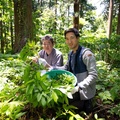"I can see glimpses of my childhood in my work. The seemingly endless patterns we made in the dust, the shapes of the flowers and the vegetation, the translucence of a dragonfly’s wing when sunlight pours through it—these things have influenced my work.” - Ruth Asawa, 2001
Strength in Beauty
For Nisei artist Ruth Asawa, her work reflects the richness of everyday life and the beauty of ordinary things. Her intricately crocheted wire sculptures, lithographs, and drawings, speak of the organic foliage and flower forms she encountered while working on her family’s farm in Norwalk, California.
Born in 1926, the daughter of immigrant truck farmers, Asawa and her six siblings spent childhood summers working 18-hour days in the fields. While planting and harvesting crops, she observed plants, insects, and the surrounding landscapes—an inspiration for her later work.
During World War II, Asawa’s father was arrested by the FBI and incarcerated in New Mexico. The family would not see him again for more than two years; and were forcibly imprisoned at Rohwer, Arkansas. In camp Asawa spent her free time drawing and painting, and learned from Walt Disney studio artists who were also incarcerated.
Through a scholarship from a Quaker organization, Asawa left camp to pursue a career as an art teacher at Milwaukee State Teachers College. She was told she would never teach art in Wisconsin because of her Japanese ancestry, so Asawa instead studied at Black Mountain College, a progressive art school in the forests of North Carolina. There, she learned a simple, yet revolutionary philosophy where no separation existed between an artist’s work, their studies, and the chores of daily life. Under the training of famed artists like R. Buckminster Fuller and Josef Albers, Asawa took classes in drawing, painting, color, and design, while working on the farm, completing chores in the kitchen, and hauling coal for heat.
In 1949 Asawa married fellow student Albert Lanier; they moved to San Francisco and raised six children. Her life as a mother was inseparable to her work. “There were no divisions between work and play for her,” recalls daughter Aiko Cuneo. “She might put down an art project and start cooking dinner, but for her cooking was just another project, another way to make something beautiful.”
The Sculpture of Ruth Asawa: Contours in the Air is a retrospective exhibition celebrating the life and work of one of the most important Japanese American artists of the twentieth century. Organized by the de Young Museum in San Francisco, this exhibition features more than 100 works of art and opens at the National Museum in March 2007.
* * *
See the work of Ruth Asawa at the Japanese American National Museum. Exhibition closes May 27, 2007.
The Sculpture of Ruth Asawa: Contours in the Air, a book of essays, and other Ruth Asawa items can be purchased at the Japanese American National Museum Online Store.
* * *
* This article was originally published in the Winter 2006 issue of the Japanese American National Museum Member Magazine.
© 2006 Japanese American National Museum







